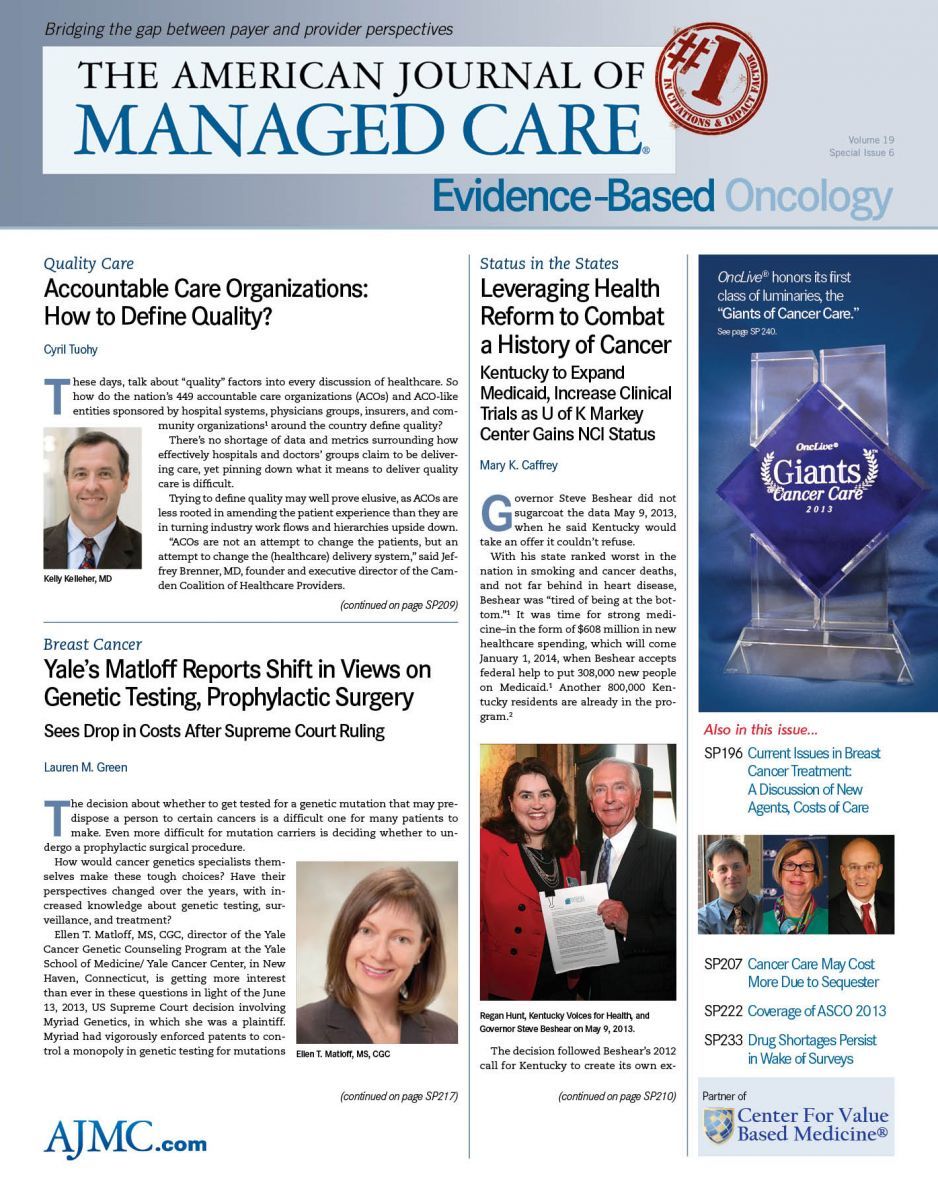- Center on Health Equity & Access
- Clinical
- Health Care Cost
- Health Care Delivery
- Insurance
- Policy
- Technology
- Value-Based Care
Bevacizumab Aids Survival in Cervical Cancer
Bevacizumab (Avastin) combined with either of 2 chemotherapy backbones improved overall survival (OS) by 3.7 months versus chemotherapy alone in patients with advanced cervical cancer, according to data from the phase III GOG 240 study. The likely practice-changing results were presented at a press briefing at the 2013 ASCO Annual Meeting.
“This is the first time that an overall survival benefit [with a targeted drug] has been shown in cervical cancer. This is a paradigm shift—patients live longer and feel better,” said moderator and ASCO spokesperson Jyoti D. Patel, MD, an oncologist at the Robert H. Lurie Comprehensive Cancer Center of Northwestern University in Chicago, Illinois.
The standard of care for newly diagnosed cervical cancer is cisplatin plus paclitaxel, and some patients are cured when treated with radiation plus cisplatin-based chemotherapy. However, the treatment options are highly limited for those patients whose disease progresses. These patients often become resistant to cisplatin, and “Unlike some other solid cancers, cervical cancer doesn’t really respond to different chemotherapies…so we need some new therapeutic options,” said lead GOG 240 study author Krishnansu S. Tewari, MD, a professor of Obstetrics and Gynecology at the University of California, Irvine, who presented the results at the ASCO press conference.
Researchers decided to test the antiangiogenic VEGF inhibitor bevacizumab in this setting because “angiogenesis is very active in cervical cancer,” according to Tewari. In the 4-armed GOG 240 trial, 452 women with recurrent or metastatic cervical cancer were randomized to 1 of 2 chemotherapy regimens alone or combined with 15 mg/kg of bevacizumab. The chemotherapy regimens were cisplatin (50 mg/m2) plus paclitaxel (135-175 mg/m2) and topotecan (0.75 mg/m2 days 1-3) plus paclitaxel (175 mg/m2 day 1). Treatment was administered on 21-day cycles until complete response, unacceptable toxicity, or disease progression.
The researchers included the noncisplatin chemotherapy arm with their analysis because of the resistance concern with repeated cisplatin treatment. Topotecan plus paclitaxel was selected because a phase II trial in this population showed that the regimen is active in this population. Patient characteristics in the four GOG 240 study arms were comparable with regard to age, histology, performance status, previous use of platinum as a radiosensitizer, and recurrent, persistent, or advanced disease. Overall, there was a significant improvement with the primary endpoint of OS for patients receiving bevacizumab.
At a median follow-up of 20.8 months, OS with bevacizumab plus chemotherapy was 17.0 months versus 13.3 months with chemotherapy alone (hazard ratio = 0.71; 95% CI, 0.54-0.94; P= .0035). The survival rate did not vary significantly between the two chemotherapy arms. Response rates (level of tumor shrinkage) were better for patients receiving bevacizumab: 48% versus 36%, respectively (P = .00807).
Tewari said bevacizumab also improved progression-free survival (PFS), but did not present the PFS data at the press briefing. We feel [these results] are clinically meaning in a population of patients that doesn’t respond to chemotherapy very well,” said Tewari. Regarding toxicities, higher rates of grade 3-4 bleeding (5% vs 1%), thrombosis/embolism (9% vs 2%), and gastrointestinal fistula (3% vs 0%) were reported with combination bevacizumab treatment versus chemotherapy alone. Additionally, there were four fatal adverse events in both the bevacizumab and nonbevacizumab treatment groups.
Discussing the toxicity profile, Tewari said, “We found no new toxicities associated with bevacizumab. The toxicities were similar to what had been previously reported [with bevacizumab treatment] in other types of cancers.” GOG 240 also used patient-reported outcomes to compare quality of life between the treatment groups and found little variance. “The [QoL] assessment indicates that the survival gains associated with bevacizumab did not come at a decrease in quality of life,” said Tewari.
Regarding the next steps for the GOG 240 study, Tewari said that the manuscript for the study has been written and will soon be submitted for review and publication. He said that he does not know the specific timeline for when Genentech, which manufactures bevacizumab, might submit an application to the FDA for a cervical cancer indication for bevacizumab. He did note, however, that it is likely that Genentech will begin communicating with the FDA soon about the potential to expand the drug’s indication.
1. Tewari KS, Sill M, Long III HJ. Incorporation of bevacizumab in the treatment of recurrent and metastatic cervical cancer: a phase III randomized trial of the Gynecologic Oncology Group. J Clin Oncol. 2013;31(suppl; abstr 3).

HEDIS Glycemic Goal Achieved Using Control-IQ Technology
December 22nd 2025A greater proportion of patients with type 1 diabetes who used automated insulin delivery systems vs multiple daily injections achieved the Healthcare Effectiveness Data and Information Set (HEDIS) glycemic measure.
Read More
Linking Data to Determine Risk for 30-Day Readmissions in Dementia
December 22nd 2025This study found that certain characteristics in linked electronic health record data across episodes of care can help identify patients with Alzheimer disease and related dementias at high risk of 30-day readmissions.
Read More
Performance of 2-Stage Health-Related Social Needs Screening Using Area-Level Measures
December 19th 2025Limiting health-related social needs screening to lower-income areas would reduce screening burdens; however, this study found a 2-stage screening approach based on geography to be suboptimal.
Read More
Impact of Medicaid Institution for Mental Diseases Exclusion on Serious Mental Illness Outcomes
December 17th 2025Medicaid’s Institution for Mental Diseases (IMD) rule bars federal funding for psychiatric facilities with more than 16 beds, but findings indicate that state waivers allowing treatment of serious mental illness in IMDs do not increase overall psychiatric hospitalizations.
Read More

